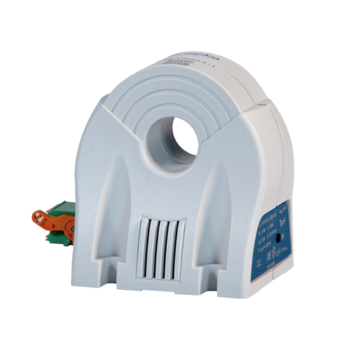residual current monitors DCTR A 020/0,30-I
- 20 mm Ø (inner), Type A
- Residual operating current I∆n
- emits an instantaneous nominal response residual current via the 4-20 mA interface
- monitored circuit max. 690 V (AC), 200 A
- alarm message via relay


residual current monitors DCTR A 020/0,30-I
- 20 mm Ø (inner), Type A
- Residual operating current I∆n
- emits an instantaneous nominal response residual current via the 4-20 mA interface
- monitored circuit max. 690 V (AC), 200 A
- alarm message via relay
Details
Residual current monitor, 4–20 mA interface, Type A, 20 mm
Residual current monitors (RCM) reliably detect and report fault and differential currents without switching off the system. They are used wherever the system cannot be switched off, or this is not desired. Residual current monitors from series DCTR have an integrated bushing transformer offering compact design and easy installation. The device continuously detects the height of the current differential current (residual current). This value is reproduced proportionally as a 4-20-mA signal. If the fixed response threshold is exceeded, a potential-free changeover contact activates. A multicoloured LED signals this status (red) or that the device is ready (green). Monitors with residual current characteristic A detect sinusoidal AC currents as well as pulsating DC residual currents. Devices in standard design are intended for monitoring circuits with a rated voltage of up to 690 V and a rated frequency of 50 to 60 Hz.
suitable for detecting Type A residual currents, monitored frequency range 50 Hz–60 Hz, Rated voltage of monitored circuit up to 690 V, Alarm relay with potential-free changeover contacts, dependent on auxiliary voltage, compact, robust plastic housing, easy mounting
The devices are mounted on stable substrata using the supplied mounting brackets.
The monitoring device is suitable for use in power supplied to purpose-built buildings and industrial facilities with TN-S, TN-C-S networks and IT networks, such as in server rooms for data centres, laboratories, in the automotive industry and in conjunction with air conditioning systems, printing machines and packaging machines, Not permitted for use in TN-C networks and direct current networks; not permitted for monitoring systems in which electronic equipment may cause DC residual currents or residual currents with frequencies not equal to the rated frequency of the RCCB.
RCMs may not be used to realise protective measure ‘Automatic switch-off of power supply’ as per DIN VDE 0100-410 (an RCM does not replace an RCD).
- Operating instructions
- Data sheet
- Text for invitation to tender RTF
- Text for invitation to tender GAEB XML
- Text for invitation to tender GAEB 2000
- Text for invitation to tender GAEB 90
- Dimensional drawing Group view
- STEP file
- Wiring diagram Pin assignment for ten-pin female connector (de-energised)
- Wiring diagram 4–20 mA interface design
Residual current monitor, 4–20 mA interface, Type A, 20 mm
Residual current monitors (RCM) reliably detect and report fault and differential currents without switching off the system. They are used wherever the system cannot be switched off, or this is not desired. Residual current monitors from series DCTR have an integrated bushing transformer offering compact design and easy installation. The device continuously detects the height of the current differential current (residual current). This value is reproduced proportionally as a 4-20-mA signal. If the fixed response threshold is exceeded, a potential-free changeover contact activates. A multicoloured LED signals this status (red) or that the device is ready (green). Monitors with residual current characteristic A detect sinusoidal AC currents as well as pulsating DC residual currents. Devices in standard design are intended for monitoring circuits with a rated voltage of up to 690 V and a rated frequency of 50 to 60 Hz.
suitable for detecting Type A residual currents, monitored frequency range 50 Hz–60 Hz, Rated voltage of monitored circuit up to 690 V, Alarm relay with potential-free changeover contacts, dependent on auxiliary voltage, compact, robust plastic housing, easy mounting
The devices are mounted on stable substrata using the supplied mounting brackets.
The monitoring device is suitable for use in power supplied to purpose-built buildings and industrial facilities with TN-S, TN-C-S networks and IT networks, such as in server rooms for data centres, laboratories, in the automotive industry and in conjunction with air conditioning systems, printing machines and packaging machines, Not permitted for use in TN-C networks and direct current networks; not permitted for monitoring systems in which electronic equipment may cause DC residual currents or residual currents with frequencies not equal to the rated frequency of the RCCB.
RCMs may not be used to realise protective measure ‘Automatic switch-off of power supply’ as per DIN VDE 0100-410 (an RCM does not replace an RCD).
- Operating instructions
- Data sheet
- Text for invitation to tender RTF
- Text for invitation to tender GAEB XML
- Text for invitation to tender GAEB 2000
- Text for invitation to tender GAEB 90
- Dimensional drawing Group view
- STEP file
- Wiring diagram Pin assignment for ten-pin female connector (de-energised)
- Wiring diagram 4–20 mA interface design
